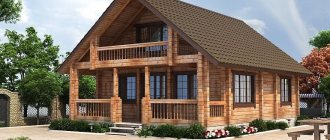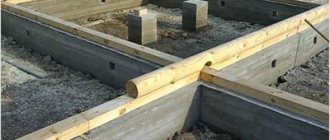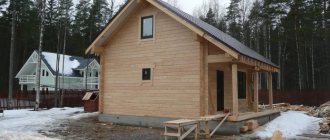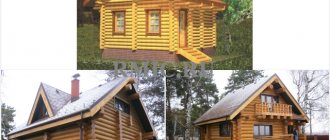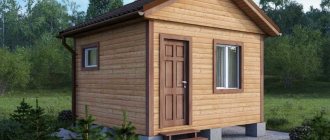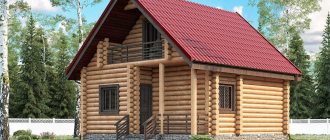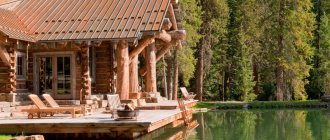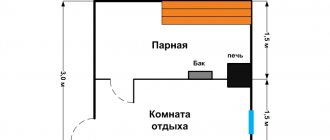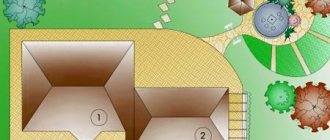Home > Architecture > Bathhouse projects > Project of a large three-bedroom bathhouse in the Tver region
10/22/2018 | Category: Architecture, Bathhouse projects
The tendency to combine a bathhouse with temporary housing, in which the owners of the site can live comfortably until the main house is ready, is becoming increasingly popular every day, especially since in the future the living quarters can be used as guest rooms.
This project of a large bath house was no exception, for the development of which clients from the Tver region turned to our architectural bureau.
What should be in every bath?
Mandatory premises include the steam room itself, a dressing room and a shower room. Of course, the layout may vary somewhat (for example, when a steam room is combined with a shower room). But these three rooms are the main ones, and they will be responsible for the quality and your comfort during bath procedures. Often, only these rooms are provided in a small bathhouse. If you can afford a larger building, then it can successfully accommodate a toilet, a small swimming pool, and so on.
About the role of the waiting room
The first place you get from the street when entering the bathhouse is the dressing room. It would seem that it’s hard to call it a full-fledged room, but when building a bathhouse, you can’t do without it. Firstly, it protects the internal space from cold air entering from the outside. And with the correct calculations, the steam room stove will be able to transfer heat into it. Therefore, even in winter, when you enter the dressing room, you will not feel cold or discomfort. Secondly, it can also play the role of a kind of utility room. And depending on individual needs, you can store various necessary things in it. If the bathhouse itself is planned to be small, the dressing room will also be used as a changing room. In this case, you will need to make shelves, cabinets or attach hooks on the walls.
As a rule, two doors lead from the dressing room: one from the street, the other to the shower, relaxation room or directly to the steam room. In front of the dressing room there may be a veranda or a small terrace. And if a rest room is not provided for in your project, in the warm season its functions can be performed by a dressing room together with a terrace. You can also welcome guests there and even set up a grill or barbecue.
Sometimes a bathhouse design does not include a dressing room as a mandatory element. Thus, the entrance is directly to the relaxation room, which leads to the steam room, bathroom, and so on. It is not advisable to do this, since the larger room of the rest room takes much longer to warm up than a small dressing room. And considering that someone will constantly come here from the cold, there is no need to talk about heat accumulation at all. Therefore, if you have the opportunity to make at least the smallest purely symbolic dressing room (even at the expense of the size of the rest room), be sure to build it.
What kind of shower do you need?
There are several options for arranging it in a bathhouse:
- summer shower (it is located outside the bathhouse, so it is not advisable to consider it in more detail);
- shower stall or hydrobox;
- static shower on a built-in tray;
- shower-tub.
Depending on the size of the room, the installation of one or another type of shower is determined. For some, a shower is generally unacceptable in a bathhouse, since traditionally only a bucket-tub is used there. For others, it is important to decorate the interior in one style, so he will never put a hydrobox in a wooden bathhouse. And, nevertheless, no matter what your choice is, you need to allocate a separate room for a shower. Especially if both men and women visit the bathhouse at the same time. If you plan to take bath procedures exclusively in the company of men, then it is quite possible to allocate one of the corners in the bathhouse for a shower, without devoting a separate room for it. The rest of the space will be occupied by the relaxation room or the steam room itself.
Sometimes a sink is used not only for its original purpose, but also serves for household needs at the same time. This feature should be taken into account and, if possible, a more spacious shower room should be included in the project.
The steam room is the most important element of the sauna
This is, in fact, the heart of any bathhouse! This is where you can truly gain strength, get rid of negative energy and get a boost of energy until your next visit. The most correct and optimal solution for placing a steam room is away from the front door. And this is logical - so that the room warms up as quickly as possible, and the heat does not escape from it through the door cracks.
Depending on the number of people who can visit the bathhouse at the same time, you should calculate the size of the steam room. If it is intended for one or two people, one shelf with a back is enough. When the dimensions allow and there is a need, you can install several shelves in two rows - one is slightly higher than the other.
The size of the steam room depends entirely on several important factors.
- Bathhouse material.
- The number of people visiting the steam room at the same time.
- The height of the tallest person who will be in the steam room.
- Fire distance of the stove from the wall.
- Will people sit in the steam room or lie on the shelves?
- How many of these same shelves need to be arranged?
- Dimensions of the stove and the material from which it is made.
Despite the fact that the steam room is practically the most important element of the bathhouse, its arrangement is quite simple. And the oven plays a significant role in it. There are several types of ovens, each of which has its own advantages and disadvantages. So, the most popular are brick, iron and electric stoves.
But the safest of these options remains the traditional brick oven. So, at the slightest flaw, an electric one threatens to short out; it heats up very quickly, but also cools down in literally half an hour. In addition, the relatively high cost makes it unaffordable for many consumers. An iron stove is not as expensive, but it cools just as quickly, does not produce heat during the cooling process and can cause severe burns at the slightest touch. A brick oven produces high heat. When heated for a sufficiently long time, it also cools slowly, releasing heat. Stoves made of soapstone, the so-called “soapstone,” are becoming increasingly popular. Although its cost is high, it perfectly warms the steam room, is highly durable, and also has healing properties. Doctors note that a bathhouse with such a stove has a beneficial effect on human health.
The steam room is a fairly small room. But even in it you can save free space. To do this, you need to attach the shelves not to the floor, but to the wall. Under them you can put buckets, ladles and so on. In addition, such fastening will help to clean the floor more thoroughly after visiting the steam room. To make them, it is recommended to take wood that does not absorb sweat and does not emit resin. It is best to use aspen for these purposes.
The optimal shelf size for a steam room is 60x180 cm. It is necessary to leave gaps between the slats so that water does not stagnate on the wood and cause it to swell.
Additional rooms in the bathhouse
If the main thing - a dressing room, shower and steam room - must be there, then additional rooms are solely at the discretion of the owner. When finances and the size of the room allow, why not add some additional rooms that will make visiting the bathhouse a real holiday for body and soul.
What else can you arrange in a bathhouse? In this matter you should not limit your imagination. In the bathhouse it is appropriate to have a billiard room, a room for massages and spa treatments, a room with a small pool or plunge pool, and a bathroom. And if you are going to build a spacious bathhouse, then one or more of the presented premises will fit more than appropriately into the interior space.
Bathroom arrangement
A toilet is not so often found in a bathhouse, but its equipment will make the bathing day more comfortable. If you need to use the bathroom, you will not need to leave a warm room and run into the house in the cold. If you plan to visit the bathhouse with children, then an equipped toilet will be a must. Of course, it is necessary to think about the presence of a bathroom at the stage of creating a bathhouse project. If for some reason you did not do this, you will have to be content with a mobile toilet. Perhaps, in emergency cases, this is not the worst solution, but for a presentable bathhouse it is better to arrange something more comfortable.
In addition, mobile toilets have a number of disadvantages, namely:
- unpleasant odor;
- the need for frequent bowel movements;
- additional use of fillers.
As a rule, if a mobile toilet is used in a bathhouse, a separate room is not allocated for it, but is installed in one of the corners of the shower or changing room. Accordingly, it is not possible to use it when other people are present in the room. It is much more convenient when, already at the stage of creating a bathhouse project, a separate room for the toilet is provided.
And even if it is not connected to the sewer line, you can equip a toilet with a cesspool. In this case, it must be done at a distance of at least 20 m from the source of process water. The design must also provide for the fact that the sewer pipe will be located at a slope towards the cesspool. In addition, it must be additionally insulated and placed below the freezing level of the soil.
In such a toilet, it is necessary to provide high-quality ventilation so that it does not allow the unpleasant odor to spread not only throughout the bathroom, but also outside it. The ventilation pipe can pass directly through the bathroom with an exit through the roof or along the wall on the street side. Sometimes the ventilation pipe is installed directly above the cesspool. In any case, it prevents stagnant processes and gradually removes unpleasant odors.
Construction cost: timber vs. log
There is an opinion that a log house made of logs costs less than the same one made from profiled timber (it is better processed than regular timber and has locks that reduce the risk of cracks). If you look at the cost of one cubic meter of material, then this is true. But for the same project you will need much more logs than timber. If you take a 200 mm beam, then the wall thickness will be 200 mm and the height of the crown will be 200 mm. And if you take logs with a diameter of 200 mm, then a groove 10-12 cm wide is selected in it. And the thickness of the wall at the junction of two logs will be this 10-12 cm. And the height of the crown will not be 200 mm, but 100-120 mm. This is where the difference in the required volumes when purchasing emerges. Add the labor-intensive nature of the work, and it will immediately become clear why log cabins are often built from timber. If we talk about profiled timber, then its dimensions must coincide within a few millimeters. With such material, work progresses quickly: just the bowls are cut (most often with a chain saw), the insulation is laid and a new crown is placed.
When constructing a log house, a longitudinal groove is cut out in a log to “join” it with another
Another important fact: working with timber is easier. Especially with a profiled one. It has absolutely the same dimensions (if it is made well) and folds together without problems. And with a log, if it is not rounded, there is more than enough fuss.
Breakroom layout
This is not a required room, but very desirable. After all, in it a person recovers from the steam room and gains strength. And if someone suddenly becomes ill in the bathhouse, you can always put him in the rest room, let him catch his breath, and drink water. Therefore, even if you are planning a small bathhouse, try to allocate at least a small room in it for a relaxation room.
The situation is completely different if you are building a fairly large bathhouse. You can make several rest rooms in it, each of which will perform its own function. So, in one you can place massage couches or soft sun loungers for various spa treatments. The other can be used as a billiard room; it is enough to place a billiard table in the center.
Some bathhouses are equipped with a relaxation room with a real wood-burning fireplace, thanks to which the atmosphere is immediately filled with warmth and comfort, especially during the cold season.
Private pool in the bathhouse
You can allocate a separate room for it or connect it with a shower room. If you are planning to acquire a stationary pool, then it must be included in the design of the entire bathhouse. Such a complex project is best completed by professionals in this industry. After all, the layout includes not only measurements and location of the premises of your future bathhouse, but also has an explanatory note. It contains information on methods of cleaning the pool, installed equipment and other subtleties that you need to know during construction.
If the bathhouse has already been built, and the question of equipping a pool has only recently arisen, there are two options.
| Varieties | Pros of models |
| Mobile. | The advantage of the former is that, if necessary, a portable pool can be removed and installed in any other place. |
| Hydromassage. | They can also be considered stationary, since you cannot move them on your own. Of course, you won’t be able to swim in it, because the hydromassage pool is designed specifically for relaxation. Although this is exactly the effect that almost everyone wants to get after leaving the steam room. |
If we are talking about arranging a full-fledged swimming pool with a pit, you will need to dig a deep hole according to the dimensions specified in advance. It is much cheaper and easier to build a square or rectangular pool. But the round one looks more elegant and attractive, although this depends on the personal preferences of the owners.
A concrete foundation is laid at the bottom of the pit, for which it is best to use class W 8 concrete. Reinforcement is placed in the foundation at the level of the future walls. The foundation must be poured once, since gradual pouring in several stages significantly reduces the reliability of the entire structure. It dries within a month. It needs to be moistened periodically to prevent cracking. To decorate the walls, plaster with the addition of latex is used. This serves as additional protection against moisture. The next step is to lay the waterproofing layer. The most affordable option is PVC film.
Now all that remains is to coat the surface. For this purpose, special pool tiles are usually used. It absorbs much less moisture than tiles, so fungi and mold do not appear on it. Alternatively, you can use multi-colored glass mosaics.
Log processing
The first thing you need to know is that a log house made of logs or timber (except laminated veneer lumber) must remain under the roof for at least 8 of the driest months. Most often, a bathhouse is installed in December, finishing work begins in August. But only if these are really dry months and they are in a hurry to start the sauna. If there is no rush, it is better to wait one and a half to two years.
The ends of the logs must be coated with a special compound
There will be enough work for the drying time. After installation, the logs must be treated with solvent-based antiseptics. For example, Tikkuril has Valti Pohjusta impregnation, and Woodex Base. They will protect the wood from fungi and blueing. To prevent them from being torn during drying, the ends of the logs are coated with another composition “Teknol JRM” from the same “Teknos” or its equivalent.
The log house itself also needs processing
After the wood dries, the log is sanded, removing the bacterial treatment. This operation opens the pores of the wood, allowing it to be painted with high quality. Oil-wax is most often used to paint a log house. These products also contain a coloring pigment that gives the wood a tint. Therefore, in addition to protective properties, they also perform a decorative function.
After shrinkage, the frame is sanded and then painted
How to properly arrange rooms in a bathhouse
Here the layout depends on the preferences and convenience of the owners. However, there are some guidelines that you need to follow.
- The steam room should be located in the corner furthest from the entrance.
- It is best to install a bathroom, shower and steam room on the side of one wall.
- The dressing room should not lead directly to the steam room. It usually has two entrances: to the street and to the locker room (or rest room), and from there to the steam room.
- It is better to place a font, pool or tub with cold water opposite the steam room.
The location of the premises is the first stage in preparing a bathhouse project. To make it comfortable for you to use, you need to carefully think through all the details. To avoid any troubles, the project should be entrusted to a professional. After all, this is not only convenience, but also your personal safety.
Gas: clean, but problematic
Modern models of gas boilers for baths have many significant advantages in comparison with other types - there is no burnt smell or ash around them, and the area around it is always neat and clean. In addition, you can fully automate such a boiler room, and the boiler and burner itself are inexpensive.
In addition, gas boilers for baths are the most compact, since their weight does not exceed 50 kg, but the power is about 40 kW. Thanks to these advantages, a gas boiler can effectively heat not only a small bathhouse, but also a large bathhouse complex with a swimming pool with a total area of up to 300 m2.
Features of the layout of one- and two-story baths
All the described premises can easily be located on the ground floor. But in this case, either the bathhouse itself will take up a significant area on the site, or the interior premises will not be as spacious as dreamed. If you want a more compact bathhouse on your site, but without compromising the size of the premises, it is recommended to pay attention to the designs of two-story bathhouses. Traditionally, all “bath” rooms (shower room, steam room, swimming pool) are located on the first floor, and the second floor can generally be called a relaxation area. There will be a terrace with a barbecue and barbecue, several bedrooms, a gym, a billiard room, a mini-cinema and so on. It is important to provide an internal staircase to the second floor. After all, getting up after a steam room in the cold is not so pleasant.
If you are planning to build a bathhouse for personal use, you need to carefully consider all the details. After all, how comfortably you can take bath procedures will depend on them. As practice shows, a bathhouse is not only a steam room with brooms, but also a place to meet friends, relax, and so on. To ensure that no details cause you discomfort in the future, the layout of the bathhouse should be ideal. It is best that it consists of not only mandatory, but also additional premises. This option depends on many factors: the size and congestion of the land plot, the frequency of use of the bathhouse, the approximate number of people who can steam at the same time, and so on.
What rooms will be designed in the bathhouse depends only on your personal preferences and financial capabilities. So, for many, the bathhouse becomes almost a second, “summer” house. Therefore, they have a summer kitchen and other premises for domestic needs.
If you plan to frequently use a bathhouse with a large group, it makes sense to build it more spacious, with several lounges and a swimming pool. If bathing procedures are something ordinary and you don’t spend more than an hour here, you can get by with three standard rooms: a dressing room, a changing room-shower and a steam room.
Sealing cracks
It's no secret that even in a well-made log house there will be gaps: it is impossible to cut out a bowl so that it perfectly follows the shape of the log. Still, some gaps remain. Moreover, during the drying process, they increase, and cracks also appear and deepen.
All these cracks are sealed - caulked. For this purpose they use a tool similar to a small flat spatula and a hammer. Moss or tow is placed in the cracks. Using caulk, tuck the tow into the crack, compacting it by tapping on the handle.
This is how they caulk a jute bathhouse
If the frame was assembled with moss (dried moss is laid between the crowns for compaction), then its ends hang out of the cracks. To prevent birds from snatching it away, it is tucked inside immediately after installation. There is no need to compact or be zealous. The purpose of this treatment is only to remove hanging ends. The caulking itself is carried out later - after six to seven months.
If the log house is placed on a jute tape or tow, the first caulking is carried out after the initial shrinkage of the log house - after six months. After this, you can install windows and doors in the log house. Secondary caulking will be needed in about a year. It usually requires less time and materials than the first time.
In general, as they say, a log house “drives” all its life. Therefore, it needs to be inspected periodically and the cracks sealed. In addition to the fact that the old ones become wider, the tow is taken away for birds’ nests. You have to periodically update the finish. But this is the case if the outside of the log house is not finished with anything.
This is what a log house collected with moss looks like. The ends are trimmed, the remains are tucked into the cracks
For more information on how to caulk a log house, read the article “How to properly caulk a bathhouse and when to do it.”
